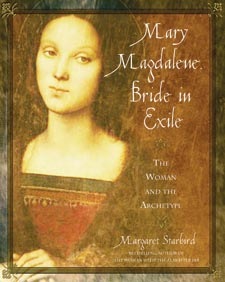The medieval unicorn is widely accepted as a symbol for Jesus Christ. In the Hebrew Scriptures we find images of the “monoceros” ("one-horned mammal") that are associated with power: “But my horn shalt thou exalt like the horn of an unicorn: I shall be anointed with fresh oil,” sings the psalmist David, blessing God for His continued support and blessings. The horn is the symbol for masculine power and virility, celebrated in ancient rites of anointing of a lingham stone representing the Life Force. Anointing of the “horn” is found also in Psalm 23: “Thou has anointed my head with oil; my cup overflows.” This assertion echoes ancient pagan rites of the “sacred marriage” uniting the king with the princess/priestess who represented her land and people. It was the role of the “Bride” to anoint the Sacred King and to be united with him in the bridal chamber, where the consummation of their marriage brought blessings of life and fertility to the people, crops, and herds of the realm.
Various exotic legends are attached to the mythical unicorn. In the popular Physiologus, a bestiary compiled in the 3rd c. in Alexandria, we find the ferocious unicorn, which can only be captured when he is lured to seek refuge with his head in the lap of a maiden. The powder ground from the unicorn’s horn was believed to be a powerful aphrodisiac and his horn was further reputed to purify polluted or poisonous waters.
These interesting
attributions are related to the image of the Unicorn as the “Bridegroom King”
of Israel, of the lineage of King David and heir to the Hebrew Bible’s promises
made by Yahweh that his descendants would rule forever. The truth that Jesus
was fully human, a virile husband and father, was denied by the tradition of
the medieval Roman Church that Jesus was the celibate son of God, ruling with
power and might from a throne in heaven. The “waters of spirit and truth” which
were to have flowed through the Christian realm, nurturing the land and people,
had been tragically distorted and perverted. Only the “horn” of the Unicorn
(the symbol for his virility) could purify the polluted waters. This 15th
c. illumination from a Medical journal illustrated by Robin Tessart depicts the
Unicorn, the “Maiden” and the purification of the stream.
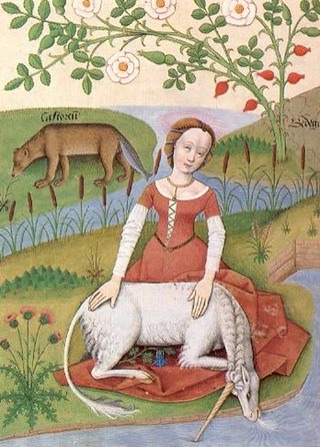
The roses above the head of the maiden and symbolic of the eternal “Feminine.” The Maiden is wearing the red commonly worn by medieval brides, while the lacing of the bodice is a style associated with pregnancy (since it enables the gown to be adjusted).
The Church fathers, who recognized the Unicorn as a symbol for Jesus Christ explain his head in the lap of the maiden by explaining that Jesus is trying to return to the womb of his mother. Clearly this is a stretch, an attempt by the Church patriarchs to co-opt the popular symbol of the unicorn, but taking away any sexual connotation of his horn. The representation of the “anointed one” in the lap of the maiden comes straight out of the ancient rites of the hieros gamos in which the Bride chooses her consort and anoints him in a ceremony foreshadowing the “anointing” that occurs in the Bridal Chamber when the nuptials are consummated.
The famous unicorn tapestries “La Dame à la licorne” celebrate the Bride in the garden awaiting this consummation of her nuptials in the final panel depicting the Bridal tent. Each panel represents one of the five senses, while the sixth celebrates the “union” of the beloveds. In the first panel, “Sight,” the unicorn has lifted the skirt of the Bride with his hooves and is gazing at his image in the mirror she holds.
 The Bride in these tapestries
is dressed in gold brocade, the wedding gown of the Bride of the Messianic king
described in Psalm 45 in the Hebrew Bible: “All glorious is the king’s daughter
within; her clothing is wrought of gold; in embroidered raiment she is brought
into the king.” In numerous medieval paintings, Mary Magdalene appears dressed
in gold brocade, and the passage from Psalm 45 was, for centuries until 1969,
part of the liturgy for her feast day, celebrated on 22 July. The Bride in these tapestries
is dressed in gold brocade, the wedding gown of the Bride of the Messianic king
described in Psalm 45 in the Hebrew Bible: “All glorious is the king’s daughter
within; her clothing is wrought of gold; in embroidered raiment she is brought
into the king.” In numerous medieval paintings, Mary Magdalene appears dressed
in gold brocade, and the passage from Psalm 45 was, for centuries until 1969,
part of the liturgy for her feast day, celebrated on 22 July. |
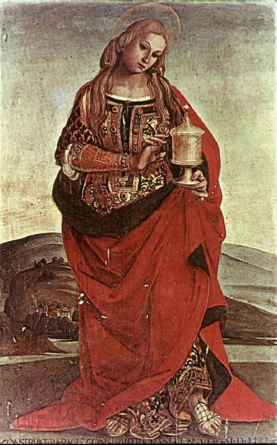
In his book about the tapestries “La Dame à la licorne,” their long time curator reports a suggestion that the tapestries represent tenets of the Cathar heresy. We have the assertion of the 13th c. chronicler, Pier vaux de Chernay, that the holocaust of the Cathars and their friends who sought sanctuary in the village church at Beziers on her feast day in 1209 as “divine providence” punishing them for their slanderous assertion that Jesus and Mary Magdalene were lovers. Apparently the belief was widely disseminated in that century, but distorted and repudiated. The Vatican and the French king collaborated to launch the Albigensian Crusade in 1209, reducing the beautiful towns of Provence to rubble.
In the "Hunt" tapestries popular in the Middle Ages, the unicorn is hunted and viciously attacked by dogs. Since the pure white unicorn is a symbol for the virile "Bridegroom" Christ, it has been suggested that in the "Hunt of the Unicorn" tapestries , the Unicorn represented the Cathar faith, hounded and eventually destroyed by the Dominican "Domini canes" ("dogs of God"), the order of Inquisitors designated by the Vatican in 1239.
Each of the early panels of the “Hunt of the Unicorn”
tapestries displayed at the “Cloisters” in New York City depicts a phase of the
hunt culminating in the extermination of the “Unicorn” (representing the
“Bridegroom Christ” and the tenet of the Cathars). But the final panel shows
the unicorn in the garden of delights, where each flower represents an aspect
of love and fertility, and the blood-red juice from the pomegranate tree above
drips on his pure white coat. The word “paradise” comes from the Persian word
for garden, and in the Song of Songs, the Bride is likened to a “garden
enclosed.”
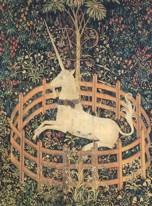 |
Among the watermarks found in
the vernacular Bibles written on paper manufactured in small paper mills
throughout the “Languedoc,” unicorns are the most popular of the images. Of
approximately 13,000 watermarks collected in the early 20th century from
antique bibles and other medieval literary works (notably the "Romance of
the Rose" and "Song of Roland'), nearly 10% are images of unicorns.
My book, The Woman with the Alabaster Jar discusses the faith of the Cathars as revealed in the
symbols they hid in sheets of paper after the faith was forced
"underground" by the Inquisition and the Albigensian Crusade
(1209-1250). One charming unicorn is very suggestive of the
“Bloodline heresy” of the “Sangraal” which asserts that Jesus and Mary
Magdalene were parents of a child whose descendants survived to become the
peers of European noble families. This unicorn watermark clearly depicts the
unicorn as associated by blood with the royal French “fleur de lis.”

Interestingly, this same distinctive flower appears to be growing in front of the fence of the enclosed garden in the “Captured Unicorn” panel of the “Hunt” tapestries. Both the watermark and the tapestries are dated c. 1500. It appears that the “heresy” of the bloodline of Jesus was widespread at that period of European history. Other watermarks depicting the “Lion of Judah” show a similar theme as illustrated below:
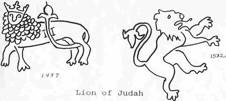
There is no verifiable proof
that Jesus, the “Bridegroom King” and his beloved Mary Magdalene had a child
and that heirs of this “sangraal” bloodline survived in Western Europe. We have
no marriage certificate for the royal couple, no birth certificate for the
Grail child. What can be proved is
that this belief was widespread in the Middle Ages, supported by art, artifact
and legend in an underground stream of esoteric wisdom, brutally suppressed by
the Inquisition of the Roman Catholic Church.
